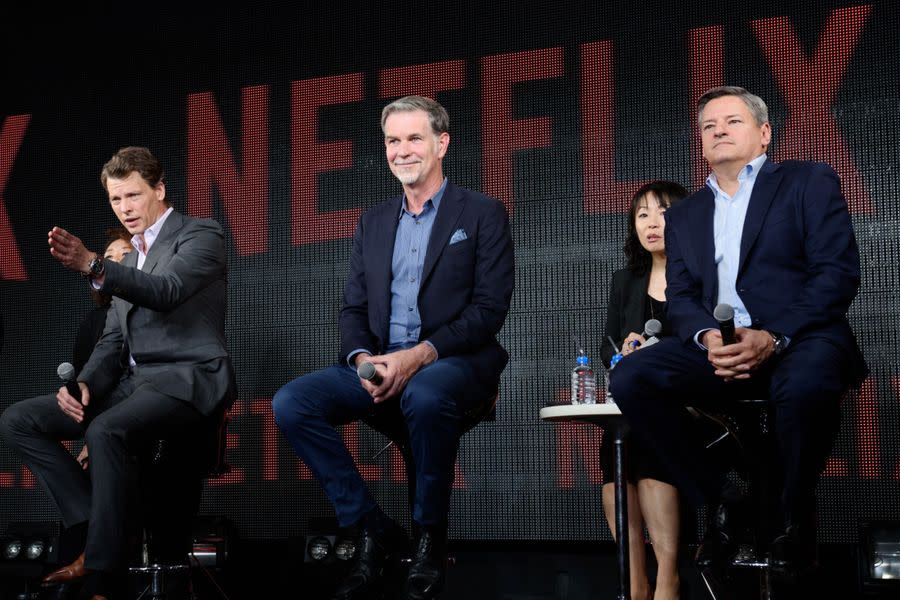The Odd Couple Steering Netflix Through a Comeback
When Netflix announced last year that Greg Peters and Ted Sarandos would become co-CEOs of the streaming giant, some executives inside the company worried the arrangement was doomed to fail.
Most Read from The Wall Street Journal
Jack Daniel’s Flowed During the Pandemic. Now Comes the Hangover.
The Wacky Negative Interest-Rate Experiment Ends With a Thud
Internal meetings over the years meant to stress-test each man’s leadership potential had highlighted how different they were. Peters, the product guru, was told he was too rigidly focused on data. Sarandos, the Hollywood czar who relishes working with talent, was told he doesn’t focus on data enough, people familiar with those discussions said.
The two executives’ camps had been at odds over the vaunted Netflix algorithm that decides which programming shows up on users’ home screens—with the Sarandos side pushing to override it sometimes to make sure that certain shows or movies were featured. At one point, the company tested out a new row, internally dubbed the “Ted Row,” to resolve those tensions.
The co-chief-executives’ arrangement didn’t look like a recipe for success. But so far, the naysayers’ fears are being proven wrong.
Under Peters and Sarandos, Netflix has bounced back from the hit its business suffered two years ago, when a rare drop in subscribers shook Wall Street’s faith in its dominance in streaming.
Since then, Netflix has found new ways to grow—including by cracking down on password sharing—and its stock has taken flight, more than doubling in a year. Netflix is profitable, while rivals such as Disney and Paramount are struggling to make money on streaming.
The co-CEO model is out of vogue. Companies such as BlackBerry predecessor Research in Motion, Salesforce and Oracle have tried and abandoned the model. The conventional wisdom is that the structure leads to confusion over who makes the big decisions and blurs accountability.
At Netflix, that Peters and Sarandos are polar opposites—from very different but equally powerful wings of the company—might have turned out to be an advantage, making it easier to split up responsibilities harmoniously.
Netflix is unique among the titans of entertainment in that, from its inception, it was both a tech company and an entertainment company. The engineers who made streaming possible were celebrated as much as the people behind the programming strategy that created “House of Cards” and “Stranger Things.”
“I think the media industry more today than ever before needs two skill sets at the top of the house,” creativity and commercialization, said Mike Speck, a partner at leadership advisory firm Heidrick & Struggles. “Sometimes you find someone who has both—it’s not that often.”
Wrestling matches
There have been some areas of friction. At a meeting for company executives in Los Angeles earlier this month, Peters acknowledged that the two men disagreed over whether to strike a deal for WWE wrestling rights, attendees said. They got on the same page and Netflix reached a $5 billion, 10-year deal.
Sarandos has raised questions about some of Peters’s initiatives, including what the long-term plan is for Netflix’s foray into gaming, according to people familiar with the situation, while Peters has questioned Netflix’s spending on certain movies and shows.
To help with the transition, Netflix brought in an executive adviser who had given succession-planning advice to business titans including Disney Chief Bob Iger and longtime Estée Lauder leader Leonard Lauder.
“For this to work out, it wasn’t just about Greg and Ted being experts in their domains, but about building a strong relationship between the two of them,” said Bill Holmes, the former head of business development at Netflix. “That was new to Netflix.”
Together, they are starting to put their stamp on Netflix’s culture, with internal discussions under way to re-examine core principles such as employee freedom, given that the company is maturing and facing new business pressures.
On investor calls, Peters and Sarandos generally stick to their own expertise, passing the baton between them.
“So with that, I tag team to my partner, co-CEO,” Peters said on a January call.
Through a spokeswoman, Peters and Sarandos declined to be interviewed. Peters told tech site Stratechery in January that while Netflix doesn’t need to have co-CEOs to succeed, it is well-suited for the model. “There’s these two very deep, very important centers of expertise, and we get to have a CEO who’s hopefully, I’ll say with a little bit of humility, good at both of those.”
The schmoozer and the blender
Sarandos, a community college dropout who started out working in a video-rental store, climbed that industry’s ranks before joining Netflix in 2000. As chief content officer, he had the foresight to create the streamer’s original programming strategy, recognizing that it would get harder and more expensive over time to license movies and shows from Hollywood competitors. The 59-year-old is a superfan of stand-up comedy and TV sitcoms, and reveres the late Norman Lear, the writer and producer of 1970s hit TV comedies.
Sarandos spends time out of the office schmoozing with Hollywood A-listers, sometimes inviting them to his home, where he has been known to cook pizza in his wood-burning oven. He once vacationed on a private island in French Polynesia with Leonardo DiCaprio and counts stand-up comedians, including Dave Chappelle and Jerry Seinfeld, among his friends.
Peters, 53 years old, was a member of the Air Force who once had ambitions to be an astronaut and has a degree in physics and astronomy from Yale. He joined Netflix in 2008 from tech company Macrovision Solutions. While Peters enjoys entertainment—the sci-fi classic “Blade Runner” and Netflix series “One Piece” are among his favorites—his interests span broader: He is a seasoned pianist and wine connoisseur.
Peters is at home discussing the science behind just about anything. He once got into a debate with Neil Hunt, Netflix’s former head of product, about the weight of a “bit”—a unit of information in computing. At a dinner with colleagues, he asked the waiter to put the wine in a blender because he thought it hadn’t opened enough.
Peters is an avid tennis player and health nut who has been known to bring vitamin gels and a thermos of tea to meetings. An intensive competitor, he once turned a bike ride with colleagues in Holland from a casual outing into a race.
Netflix co-founder Reed Hastings, who was CEO for most of Netflix’s existence, told colleagues that Peters and Sarandos each had potential to succeed him and began giving each more responsibility.

In 2015, online education company Coursera was courting Peters. To keep him, Hastings made Peters the first general manager of Japan, creating a new structure under which Sarandos’s content staffers in Japan would report to Peters. Sarandos pushed back on the idea, saying the old structure was working fine around the world, according to people familiar with the discussions. Hastings overruled him.
A couple of years later, Hastings replaced Hunt as head of product with Peters, a move that shocked Netflix staffers.
Hastings also gave Sarandos additional responsibilities, including marketing and communications. Eventually, Hastings promoted him in 2020 to serve as co-CEO, while also giving him oversight of legal and policy. Peters was promoted to chief operating officer at the time.
Algorithm wars
As Sarandos and Peters moved up the ladder, there were constant tensions between their two groups: product and content. At times, Sarandos and his team would want a particular show or movie to be highlighted on the Netflix home screen to appease the creators or actors involved.
Netflix had a row on the home screen that highlighted new releases, but it was tailored to each user’s viewing patterns by Netflix’s algorithm. A fan of dramas might see fewer sitcoms in that row, for example.
When the comedy “Friends from College” made its debut on Netflix, Fred Savage, who starred in the show, and Nicholas Stoller, one of its creators, complained to Sarandos’s team about not being able to find the show.
It was one of several incidents that Sarandos and his team had to manage with talent and would raise with Peters’s team, which resisted overriding the algorithm. Eventually, the two sides compromised by testing out the “Ted Row,” which showed all households the same new releases—no matter what the Netflix bot wanted. Netflix discontinued it after finding that it didn’t improve user engagement.

Even before Hastings prepared to step down as CEO and elevate Peters into the role of co-CEO alongside Sarandos, he brought in the executive adviser, Marc Feigen, for succession-planning help.
In the setup that was announced in early 2023, content, marketing and legal went to Sarandos, while product, HR, technology, advertising and gaming went to Peters. A few months later, Feigen found that some employees still weren’t clear on lines of communication—which executive they were supposed to update on which topics. Sarandos and Peters quickly addressed the issue.
The business results have been strong. Netflix last year increased the number of subscribers about 13% to more than 260 million globally. Netflix’s customer turnover remains low at around 2%, despite the password-sharing crackdown, according to research firm Antenna.
The real test of the co-CEO partnership will come if the company hits another rough patch—if growth stalls and pressure to cut costs increases—or if the executives have to spar over which new initiatives should get investment.
Tough, candid conversations are crucial to make the co-CEO model work, said Scott Taylor, a professor of organizational behavior at Babson College. “When you see co-CEOs fall apart, it’s often because the nature of the relationship is territorial and there is a lack of clarity around each one’s direction,” Taylor said.
Write to Jessica Toonkel at jessica.toonkel@wsj.com
